Matador Network's Blog, page 853
May 21, 2020
Skift survey on summer 2020 travel

In an ideal world, a pandemic would transcend politics. Name any issue you can think of — from immigration to the aesthetic value of garden gnomes — and you’ll probably find a political divide. It’s no surprise, then, that the coronavirus crisis is causing a gaping chasm between Democrats and Republicans, and that extends to its impact on tourism. Skift surveyed 528 US citizens — members of both parties, as well as Independents — asking them about their travel plans over the next several months. The results not-so-shockingly showed a disparity in the opinions of Democrats and Republican respondents.
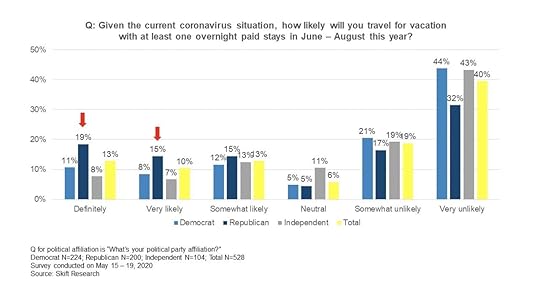
Photo: Skift
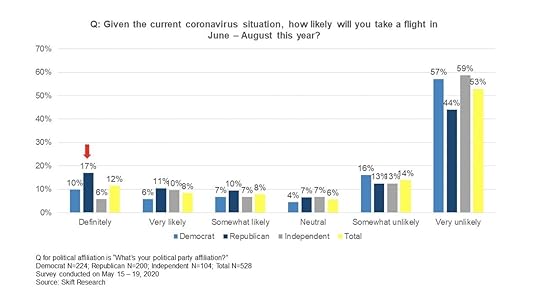
Photo: Skift
According to the survey, Republicans are more eager and willing to return to travel than Democrats. About 35 percent of Republicans said they are planning to travel over the summer, with at least one overnight stay, compared to just 20 percent of Democrats.

Photo: Skift
When asked if they would take a flight this summer, Democrats expressed more trepidation than their Republican counterparts. Fifty-seven percent said they were “very unlikely” to fly this summer versus just 44 percent of Republicans. In a similar vein, more Democrats also believed that states were reopening too soon. Only 23 percent of Democrats thought states needed to reopen faster while 57 percent of Republicans favored a much quicker reopening.

Photo: Skift

Photo: Skift
In line with the rest of these results, 69 percent of Republicans believed that the government had “done enough” to support the travel industry — perhaps explaining their confidence in booking a flight — compared to just 39 percent of Democrats. 
More like this News Matador Network survey reveals an overwhelming eagerness for post-pandemic travel
The post New study finds Republicans are way more likely to travel this summer than Democrats appeared first on Matador Network.

Less inclusive travel post COVID-19
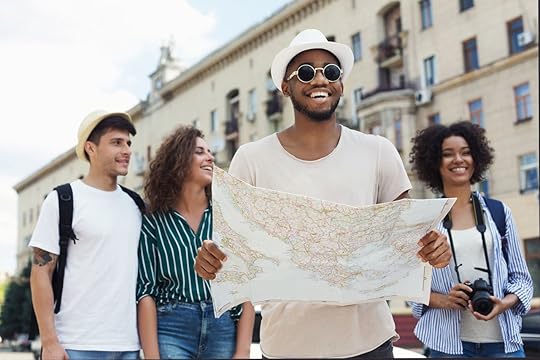
A world in which we can once again travel freely is creeping into view.
Greece has announced its plans to welcome international travelers by June 15. Mexico’s Los Cabos and Quintana Roo, home to tourist magnets Cancun and Tulum, hope to reopen on the first, while St. Lucia intends to be the first Caribbean island to reinstate tourism. Iceland is similarly looking to ease restrictions in a matter of weeks, pledging to provide COVID-19 tests at Keflavik International Airport to determine if visitors will be required to quarantine for 14 days upon arrival.
Faced with the inevitable yet uncertain future of travel, many are left questioning what, exactly, that future will entail, and how it might become more burdensome: Will face masks and temperature checks become status quo? Will the recommendation to arrive three hours before an international flight triple? Should we expect to budget two weeks of isolation into every trip?
These questions are valid, but what they fail to consider is that even a future in which travel is less comfortable or convenient than it was pre-pandemic is a privilege many Americans, and others around the world, may no longer have access to.
It was not so long ago that leisure travel was reserved for the elite. A lot has changed in the century since commercial aviation revolutionized international transit: Etihad outfitted its most expensive suites with showers and 32-inch LCD TVs. Five-star hotels were built underwater, sculpted out of snow, and erected among the treetops.
Yet despite the ways in which travel has become more exclusive, its greatest advancement is exactly the opposite: Over the past 50 years, opportunities to see the world have been wildly democratized.
Air travel, in particular, has helped travel trend in favor of the masses. Roughly 60 years after that first commercial flight in 1914, Pacific Southwest Airlines became the world’s first low-cost airline, operating flights between Northern and Southern California. To date, there are over 100 budget airlines servicing Africa, Asia, Europe, Oceania, and the Americas.
The past decade’s endorsement of home-sharing platforms like Airbnb has similarly made securing accommodation at a comfortable price point easier and more accessible than ever.
With the masses now stuck in their own homes, collectively unable to travel much farther than their living rooms, COVID-19 has appeared to level the playing field once again. In reference to its non-discriminatory nature, New York Governor Andrew Cuomo and others have even labeled the virus a great equalizer.
Yet, as many have since pointed out, COVID-19 is no equalizer. Its outbreak has only exacerbated the inequalities that already exist in the United States and beyond.
Low-income workers and people of color have been disproportionately affected by the pandemic in the United States. Since mid-March, more than 38 million Americans have filed for unemployment, with some 40 percent of low-income families losing a breadwinner.
The most economically vulnerable populations are bearing the financial and fatality-related brunt of the COVID-19 crisis, among them Black Americans, Hispanics and Latinos, and Native Americans, as well as service workers, single mothers, immigrants, and those with disabilities.
In many cases, members of these demographics continue to work, thereby increasing their chances of contracting the virus, in jobs that do not provide affordable health insurance.
While higher-income workers have also lost jobs, and perhaps employer-provided health insurance, the fact remains that those with a financial cushion are not surviving the same pandemic as those without. For some, lockdown has been a struggle to keep their bills paid and families fed. For others, it’s been a struggle with boredom and an opportunity to toy with the idea of traveling, once permitted, before rushing back to an office job.
Some affluent travelers have already started planning vacations for the end of the year. According to Bloomberg News, luxury safari outfitter Roar Africa’s private safaris, which run at least $60,000 per person, have seen bookings resume since early May. The appeal is as obvious for those who can afford a private safari as a private safari is unattainable for everyone else: An ultra-exclusive African getaway is as socially distant as travel gets.
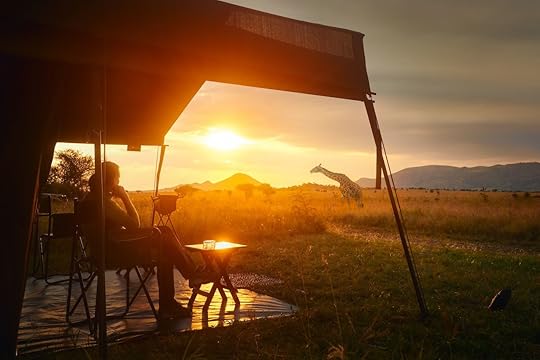
Photo: soft_light/Shutterstock
Secluded five-star hotels like the Auberge Resort in Los Cabos, Mexico, which has reportedly seen a spike in interest among holidaymakers compared to last year, are more attractive than ever. As is flying privately for anyone who has the funds.
The threat to travel’s accessibility does not stop with chartered jets, however. Those with the means to fly first or business class are likely to feel more comfortable traveling than those relegated to economy, where the promise of emptier cabins has already fallen short.
Take Brian Kelly, founder of the popular travel website The Points Guy, who recently penned an article outlining the reasons he’s ready to resume traveling. “I feel confident that with the right precautions,” he writes, “like wearing a mask and ideally flying in my own business class seat without a seatmate, I can start traveling again.”
Though Kelly built his reputation on blogging about how to maximize airline points to travel above his means, his words here evidence a wider-reaching sentiment: Travel, at least for a time, may once again trend toward the elite.
And it’s not just travelers setting the trends.
When Greece announced its plans to salvage a summer tourist season, Prime Minister Kyriakos Mitsotakis told CNN that high-end travelers were critical to resuscitating the country’s cash flow. He cited socially distant, and prohibitively expensive, yachting as an example of the type of tourism he intended to promote.
While it’s unclear if, or how much, visitors to Iceland will be expected to pay out of pocket for a COVID-19 test that, pending a negative result, would exempt them from a 14-day quarantine upon arrival, Austria’s Vienna International Airport has already put a price tag on its tests: roughly $250.
Elsewhere, in countries such as New Zealand, Australia, and the Baltic states, governments are experimenting with “travel bubbles” and lessened restrictions that will nonetheless continue to impede free travel. As these restrictions ease, some passport-holders will inevitably be welcome sooner than others depending on their nation’s infection rates, which could lead to discrimination, intentional or otherwise.
Between closed borders that seem unlikely to budge anytime soon, the folding of budget airlines and fewer available Airbnbs, and destinations reverting to prioritizing luxury travelers, the future of travel is more precarious for some than others. Flights may be affordable now, while airlines struggle to survive, but as travel regains normalcy these prices are likely to skyrocket, excluding those whose finances no longer allow for nonessential spending.
The fact of the matter is that millions of Americans will have little to no expendable income in the wake of the COVID-19 outbreak. People have lost their jobs, depleted their savings, maybe even suffered non-refundable costs from canceled trips they worked hard to afford.
Whirlwind European tours were never an option for everyone, but the idea of pulling off a once-in-a-lifetime trip within an actual lifetime has been a more attainable dream in recent years than ever before. Now, travel in general, whether a week in the Carribean or a long weekend at Disneyland, may no longer be in the realm of possibility for many.
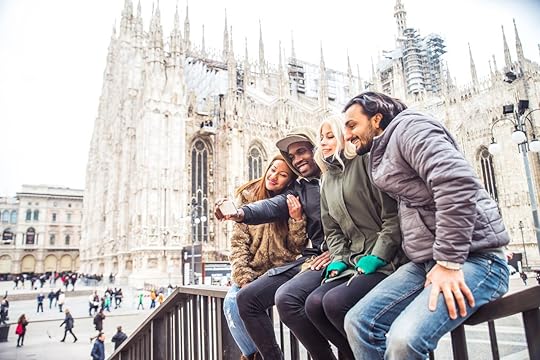
Photo: oneinchpunch/Shutterstock
It’s sad to think about a world without travel. It’s even sadder to think of a world in which only a select few have the means to do it. The benefits of seeing a new place, meeting new people, and learning a new culture extend far beyond the digital mementos we litter on social media.
Travel is an education. It’s an exercise in empathy. It helps connect a world that often needs reminding of just how connected it is, particularly in dark, tense, and isolating times.
If the last few months have taught us anything, it’s that concerted efforts to sustain that connection can yield creative solutions to seemingly insurmountable challenges. As the world begins to reopen, it will be imperative that those in power do not sacrifice accessible travel for the survival of an industry that will ultimately suffer at the hands of exclusivity.
Whatever fears we have about the future of travel, the scariest future is one that reverses decades of democratization. Annoying as it may be to imagine TSA lines made that much longer by everyone standing six feet apart, we can only hope travel’s worst-case scenario still includes everyone. 
More like this Lifestyle Twitter allowing employees to work from home forever could signal the end of the office
The post We can’t let COVID-19 be the end of inclusive travel appeared first on Matador Network.

Third Climate Win for May 2020
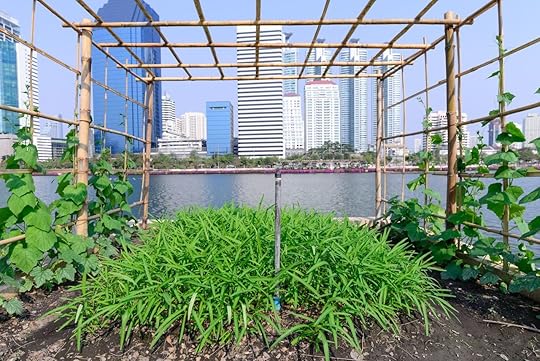
The coronavirus pandemic has led to a resurgence of home and urban gardening that some say harkens to the Victory gardens planted during World War II. An increase in home gardening is positive on many levels, not least because raided store shelves and the panic-buying of chickens for homegrown eggs have exposed how fragile our food systems are.
To sustainably feed the estimated 10 billion people that could live in cities by 2050, however, the world must think large-scale. Decimating rainforests and other biodiverse landscapes to raise livestock and grow crops has never been sustainable and has actually made it easier for disease-causing viruses to spread. To feed a growing population in a warming world, food needs to be grown closer to where it is consumed — and that means in and around cities.
While we have a long way to go to make our food systems more sustainable, modern technology, combined with community-driven and entrepreneurial minds, are moving the process forward.
Freight Farms, a company founded in 2011 in Boston, is one major player in this endeavor. The company retrofits used shipping containers into indoor farms and then sells them to restaurants, businesses, and individuals. The company’s signature product is called The Greenery, which uses vertical hydroponics to grow an optimal amount of food in such a confined space. While the units aren’t cheap — costing around $80,000, according to CNN — they are retrofitted to produce enough food to sell, meaning enterprising urban farmers could stand to make long-term profits.
While not everyone can afford a converted shipping container, many major cities are getting creative with how they grow. Densely populated urban areas with high concentrations of high-rise buildings have the prospect of green walls and rooftop farms, along with other forms of large-scale vertical growing. Bowery Farming has a good model that, with proper investment and interest, could be easily replicated in urban areas around the country — bringing modern technology like LED lighting and remote control operation into compact quarters to grow produce at scale in New York City. The company then sells this produce to restaurants and stores, helping its customers cut down on what they order from the warehouses of major food distributors.
Also in New York, City Growers is working to educate kids on the basics of urban gardening so that they come into adulthood with an understanding of where the food that they eat comes from. The group uses rooftop gardens to teach basic growing skills to inner-city kids, betting that they will use these skills throughout their life. As President Barack Obama advised graduating seniors in his digital commencement speech this week, “If the world’s going to get better, it’s up to you.”
More good news from the green front
Cities using empty space to grow food
The BBC reported this week on cities using empty space — in the case of Paris, France, unused underground parking spots — to grow food. London is even using disused war tunnels as farming space, leading us to believe that there actually is a lot more space in cities for creative solutions than we think. And that’s without exploring the depths of suburban sprawl.
Cheers to that
In the not-so-distant-future, your happy hour toast might have a new ring to it. The Guardian reported this week that renewable chemicals company Avantium has developed a plant-based lining for cardboard bottles. And, not only is the entire bottle made from renewable resources, it biodegrades in a month. Iconic Danish brewer Carlsberg is onboard to give it a go.
Going green in Dusseldorf
Dusseldorf, Germany, just got a green facelift — literally. The city’s Kö-Bogen II office building was wrapped in hornbeam hedges that generate the carbon offset of 80 deciduous trees, according to Dezeen.
Everest visible from Kathmandu
Mt. Everest is visible from Kathmandu, Nepal, for the first time that “almost anyone can remember,” reported the Nepali Times this week. The world’s highest mountain will likely disappear from view once lockdowns in the city have been lifted, but the image of what could be is now imprinted in residents’ minds. 
More like this Cycling Bicycles are in short supply right now. Here’s where to find one.
The post Urban farms are coming to a rooftop, garage, or shipping container near you appeared first on Matador Network.

What is the Finnish concept of sisu
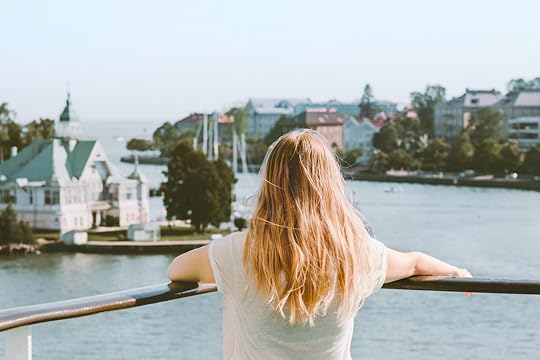
This pandemic is really tough. But we have the inner strength to get through it. If you doubt that, look to Finland. They know how to prevail through hard times, and they have a word for it: sisu.
“Sisu is a word that has been around for hundreds of years, so it’s very integral to the Finnish vocabulary and the Finnish cultural vertebrae,” said Emilia Lahti, who has pioneered research into a concept that many Finns see as a core element of their cultural identity.
People have described sisu as grit or perseverance, but Lahti clarifies that it’s more about “extraordinary perseverance.” In other words, it’s about enduring in the face of extreme, or beyond ordinary, challenges.
Lahti should know. After surviving a violently abusive relationship, she says she wanted to learn more about sisu and was surprised that not one peer-reviewed study of the concept existed. She’s now completing her PhD dissertation on the subject at Helsinki’s Aalto University.
“Sisu is determination and courage in the face of great adversity,” said Lahti. “There is something in sisu that is more like when we feel that we’ve reached the end of our preconceived or assumed amount of energy and you discover a second wind or a spare power tank.”
Finland’s story of sisu
Finns credit their history and location for their sisu. Finland has been independent for only a hundred years, following centuries of rule by Sweden and later Russia. During War War II, Finland famously fought off the Soviet Union’s winter invasion.
“Finland, being sandwiched between Sweden and the Soviet Union/Russia, there’s a long history of having to endure and defend your existence,” explained Lahti. “And it also sounds obvious, but I would say weather.” A difficult climate, explains Lahti, influences a culture.
“The weather, the cold, the darkness, and we survive in spite of all that,” said Rauno Lahtinen, a cultural historian at Finland’s University of Turku, on the origins of the concept of sisu. “Originally it was about the idea that we had survived here in these circumstances, no matter what, and that’s why we have it.”
The key element is not so much that you survive in extreme conditions, but that those conditions demand more from you. Lahti said that when she was training for an ultra-marathon across the length of New Zealand, each time she ran in Finland’s cold rain or sleet, it was a deliberate choice or, as she put it, “a self-selected moment of adversity.”
Sisu is accepting and acting
Päivikki Koskinen agrees. Koskinen is a freelance journalist and TV reporter who works with Visit Finland on its Rent a Finn campaign, where you can spend time with someone from Finland to learn how they manage to rank as the happiest people on Earth.
“It’s really accepting what is,” said Koskinen. “Even if the weather is really bad, we are accepting it’s really bad but we are still doing what we are planning to do.” Koskinen cites her recent choice to swim in an ice-cold lake for a livestream. The event was planned, and Koskinen summoned sisu to get through it.
“It demands sisu to accept that yes, it’s not always nice, and I still do it. Be in the moment, accept it, and act,” said Koskienen, emphasizing that it’s the notion of taking action — even in the face of seeming obstacles — which sets sisu apart.
“I can do this, I can do what I promised and I want to do what I promised. I want to be trustworthy” is how Koskinen says Finns view their plans or obligations. “It’s commitment. Committing to the moment.” In fact, commitment is such a central tenet that Finland is the only country that paid all its debts to other nations following World War II.
Given its association with commitment and integrity, it’s no wonder that sisu is so highly regarded in Finland. “I think we use [the term ‘sisu’] almost daily. It feels really nice if someone says to me, ‘You really have sisu.’ It’s kind of like an honor to have it,” said Koskinen.
Sisu researcher Lahti echoes that idea, “In Finland sisu is very linked to qualities such as integrity, honor.” That’s also part of what sets sisu apart from, say, grit, a psychological concept that’s been much more widely researched.
“Sisu … gives us a chance to broaden the conversation about human endurance. It’s not just that we endure, that we extract that energy and we find it, but it’s the quality of how we are enduring,” said Lahti. “Is there virtue, is there gracefulness?”
“It’s almost like an unwritten rule that you seek to endure, you don’t complain about little things,” said Lahti.
We can all find sisu
Yet despite the fact that Finns see sisu as such a uniquely Finnish trait, Lahti believes it’s a strength that exists within all of us. “The capacity for sisu is in everyone, and we can cultivate the kind of environment where it’s more likely that someone will show sisu,” she said.
Lahti concedes that it may be easier for Finns to access their sisu because they are already aware that they have it, and that self-knowledge is the first step to finding it. “First of all, start with pausing and acknowledging that there is this indestructible, unbreakable life force. There is this strength within me,” said Lahti.
The next step builds on the first since it focuses on creating your own narrative about personal fortitude. “Secondly, recollecting moments — I would call them stories of sisu from our own life — maybe even doing a writing exercise, writing down one or two or three moments where we overcame something we thought we could not do.”
As Lahti notes, “It’s an assignment that can help us remember what we’ve overcome, and that we do really have this capacity. So far you have overcome 100 percent of all the adversities you have encountered. Just remember that.”
The third step involves acting on it. Lahti is careful to stress that situations that demand sisu are very individual. “There’s a million ways to be expanded by sisu. For someone it can be a very personal thing, like I need to be courageous and speak the truth in my relationship … For some it can be a physical thing, like exercise. If you’re someone who is depressed, an act of sisu could be to get up, take a shower, and go for a walk outside.”
Now is the time to build sisu
The key is that sisu comes from challenges. “‘What is a chance in my own life that will take me to the edge of my comfort?’” is a question Lahti said we should ask ourselves. “There’s a lot of life in the comfort zone and we need to be there as well, but growth begins at the end of that comfort zone.”
One reason that Finns feel so in tune with sisu, beyond the fact that they’ve grown up with the word, is that it’s an everyday part of life near the Arctic circle. Even in the bitterest winter weather, Finnish school kids are expected to go outside multiple times a day.
These difficult “micro-moments” as Lahti calls them, build up strength over time — toughness that we can transfer into a more demanding situation. “We get to choose to do an uncomfortable thing when it’s not too hard and then when something really happens and we’re invited to … respond way beyond what we thought we were capable of, there’s this phenomenon of transference.”
Right now, many of us find ourselves outside of our comfort zone. It’s a good time to find that inner strength.
“As a global community, we are together swimming in this lake of sisu, more or less right now,” said Lahti. She notes that some people may be suffering with loneliness or depression, while others are facing severe financial consequences from the pandemic.
“We get to recognize our strength, and it also comes with a lot of elevating, amazing stories … because it is such a human quality to overcome and endure,” said Lahti. She is confident we have the capacity to get through this because, she says, “To have sisu is to be human.” 
More like this Wellness 5 breathing exercises you can do to ease anxiety
The post What the Finnish concept of sisu, or inner strength, can teach us appeared first on Matador Network.

Aurora, Colorado, restaurant scene

Suburbs aren’t often thought of as travel destinations, particularly when the nearby urban core has come into its own. But Aurora, the big and noisy suburb east of Denver proper, is finding its place as a travel destination through the diversity of its food scene.
Aurora has long been an arrival point for immigrants in Colorado. Of the city’s 375,000 residents, 19.9 percent — nearly 75,000 people — are foreign-born, according to US Census data. Aurora is a less expensive alternative for people to live and work compared to the rising costs of Denver, and many immigrants have become small business owners and opened restaurants. The result is a food culture that stands apart from the outdoors, sports, and cannabis sectors that typically draw visitors to Colorado.
“Aurora is a welcoming city with residents representing cultures around the world,” Aurora mayor Mike Coffman tells Matador. “Nothing illustrates that better than our rich culinary scene along the Havana corridor, Colfax Avenue, and throughout the community.”
The region has experienced massive growth since the mid-1990s. Denver International Airport opened on a parcel of land adjacent to the city of Aurora in 1995, replacing the old Stapleton Airport that was northwest of Aurora. Easy access for travelers, combined with the craft beer market and outdoors, drew nearly 32 million visitors to the Denver area in 2017, according to numbers from Visit Denver. The state also saw 70,000 people move in that same year and 80,000 the next, a statistic dominated by outdoors-minded (and social media-savvy) Gen-Xers and Millennials not shy about sharing the place they “discovered” with friends and family back home.
With that growth, Aurora has worked to promote the communities that already call the city home.
“In partnership with our Office of International and Immigrant Affairs and business groups like the Havana BID, we are bringing in new international eateries and are actively promoting the fact that we have the best food scene in the metro area,” Juan Mercano, an Aurora City Council member, told Matador. “Aurora’s diversity is well represented in the restaurants that call our city home, and our broad range of cuisine really exemplifies that we are an international city with a lot to offer.”
Since 2012, Aurora’s city website has maintained a dining guide called YUM AURORA to chronicle restaurants by cuisine, with dedicated sections for African, South American, Middle Eastern, and others. Modern food halls like the Stanley Marketplace, opened just north of Colfax Avenue in 2016, hosts Cheluna Brewing, the state’s first Latino-owned and -operated brewery, and casual restaurants like Misaki, a sushi counter in the market’s main hall.
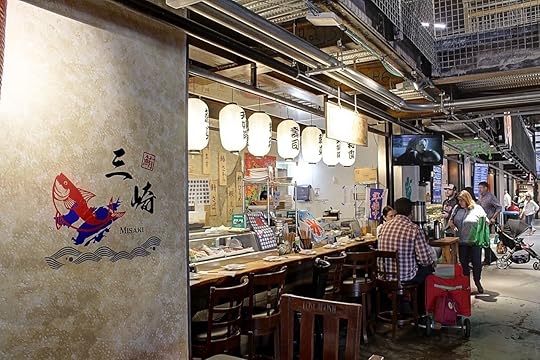
Photo: Misaki at Stanley
A tourism, visitor, and convention bureau, Visit Aurora was established in 2010 to help market these efforts.
“Aurora has definitely embraced our ethnic restaurants as something unique about our city and that we are continually promoting,” says Françoise Bergan, another Aurora City Council member.
Often, the hardest part of eating out in Aurora is deciding where to go.
One place to start is Colfax Avenue. This is where you’ll find Mango House, which opened in 2012 as a community hub and home for refugees and new arrivals in the city. Mango House offers a grocery, medical clinic, and youth center. In addition to its humanitarian services, the space is home to an international food hall with Syrian, Nepalese, and Ethiopian stalls, as well as Colorado’s first Burmese restaurant, Urban Burma.
Colfax Avenue — and particularly its eastern leg running through Aurora — has long been a hotspot for restaurants you can’t find in central Denver. Here, you can try Eastern European food at Baba and Pop’s Pierogi Shop or get your pho fix at Top Pho. Some of the best places to eat, however, are the small, family-run Mexican restaurants. Eating at every Mexican joint on East Colfax would take weeks of nonstop consumption — your best bet (unless you’re in town for a while) is to find a spot with a gathering of people outside and pull over immediately. Try traditional plates at La Costa or head to Tacos y Pupusas for the best of, well, exactly what you’d expect.

Photo: Dae Gee/Facebook
Along Havana Street, the city’s main thoroughfare, you’ll find restaurants that reflect the Korean community in Aurora. Plans had circulated a few years ago for an official Koreatown designation along Havana Street, but those were scrapped in order to prevent the image that the city was highlighting one culture over another. This would have been Colorado’s only such designation, but Bergan notes that the city would “rather celebrate all of our diverse cultures” than promote only one.
Still, it isn’t hard to see the influence the Korean community has on the city. The commercial stretch of Havana and the streets just off of it are home to more than a dozen Korean restaurants. There are spots like Funny Plus, which has a broad menu of barbecue, bulgogi, kimchi dishes, fried chicken, and other favorites. Dae Gee, a small chain with on-table grills, has a staff accustomed to walking diners through Korean-style dining.
Many restaurants are just a short walk away from each other after you hop in an Uber or take the light rail to the shopping center at South Havana Street and East Evans Ave. Head first into Yong Gung for a plate of ja jang myeon, a noodle dish with pork and black bean sauce. Should you have a dining partner, try the easily shareable jab tang bap, which is a rice dish with vegetables, pork, and seafood. A few doors down is Seoul BBQ & Hot Pot, which is known for, as the name suggests, hot pot. A few minutes south is Yum Yum Cake & Pastries, which has patbingsu, or Korean shaved ice.

Photo: African Bar & Grill/Facebook
You can also find restaurants in Aurora that serve traditional dishes from countries in Africa. African Grill & Bar is a Ghanaian restaurant operated by Theodora Osei and her husband since 2009. It originally opened in central Aurora but moved to the Green Valley Ranch neighborhood, adjacent to the airport, in 2013.
“We wanted to own our own business and introduce our food and culture to Coloradans,” says Osei, who is originally from Abura Dunkwa, Ghana. “And even though I didn’t go to culinary school, I was gifted with cooking.”
In addition to serving traditional Ghanain staples like waakye, a dish built from rice and beans, and fufu, made from pounded plantains and cassava, the family hosts African music, dance parties, and special events in the restaurant.
There’s also Nile Ethiopian, where you should try the stewed chicken, and Addis Ababa, which is one of the few places in Colorado to experience a proper east African breakfast.

Photo: Addis Ababa Restaurant
The future of Aurora’s diverse restaurant scene looks bright, despite the impact of the coronavirus pandemic. Aurora typically hosts 20 to 30 events in Havana per year, ranging in attendance from 800 to 10,000 people, says Chance Horiuchi, executive director of On Havana Street, a non-profit trade group representing the Havana Business Improvement District.
The marketing efforts appear to be paying off on a business-by-business level, as well as a collective level. The owners of Seoul BBQ recently opened Seoul Mandoo, a dumpling shop making 4,000 dumplings per day in a repurposed longtime food and drink building. The city has around 20 international markets, most smaller convenience stores and grocers, that supply both restaurants and residents. Horiuchi reports that 90 of the Havana district’s more than 120 restaurants have remained open for takeout during the coronavirus pandemic.
“The city has been really welcome to the diverse eateries in our corridor,” Horiuchi says. “I don’t think it’s ever been highlighted as much as it is now. With social media and good marketing, it’s better than it’s ever been. Aurora has really embraced being a global city.” 
More like this Food + Drink How brisket, sausage, and white bread came to define Texas barbecue
The post Diversity has made Aurora, Colorado, a destination-worthy food city appeared first on Matador Network.

Racism a public health crisis

In Franklin County, Ohio’s most populated county, officials passed a resolution on May 19, 2020, declaring racism a public health crisis.
The new declaration is part of the Rise Together Blueprint for addressing poverty in Central Ohio. It comes just one week after the Franklin County Board of health also declared racism a public health crisis.
In a statement, Commissioner Kevin L. Boyce said, “Racism has been a pandemic long before the current coronavirus pandemic. Our declaration today is important, but it’s not saying anything that hasn’t been apparent for a long time. COVID-19 has highlighted the health divide between black and white Ohioans, however, and I hope that it can be the catalyst we need to reform the whole health system so that it works for all of us equally.”
The declaration identifies two types of racism: individualized and systemic racism. Individualized racism is considered internal while systemic racism is a community model that assigns values and provides opportunity based on someone’s appearance.
According to the commissioners, both types of racism have seeped into the housing, education, criminal justice, and employment sectors. The resolution explains that “the Franklin County Rise Together Blueprint noted Franklin County’s African American residents experience dramatically higher unemployment rates (Overall: 5.7%, African-Americans: 11.1%), face a higher poverty rate as a community (Overall: 16.7%, African-Americans: 29.9%), have lower home ownership rates (Overall: 53.6%, African Americans: 33.4%), are more likely to live in neighborhoods with low performing schools and experience disproportionately higher incarceration rates (Overall: 223 per 100,000, African-Americans: 637 per 100,000).”
But both types of racism have also had far-reaching consequences on the health of people of color in Franklin County, where Black residents have a lower life expectancy than White residents; are more likely to die prematurely, have higher levels of infant mortality and lower birth weights, are more likely to be overweight or obese. In Franklin County, black residents are hospitalized at twice the rate of other demographic groups during the coronavirus crisis, the resolution explains.
John O’Grady, President of the Board of Commissioners, said in a statement, “Our community’s success depends on all Franklin County residents being able to share in it, but right now we have a system that is resulting in different outcomes for people based on the color of their skin. That’s not acceptable.” 
More like this Black Travel The 6 best destinations for black travelers in 2019
The post Franklin County, Ohio, declares racism a public health crisis appeared first on Matador Network.

José Andrés' World Central Kitchen

Nobel Peace Prize-nominated chef and philanthropist José Andrés and his nonprofit, World Central Kitchen, sprang into action to make sure vulnerable communities and front-line workers have enough to eat during the pandemic. World Central Kitchen is currently set up at Kings County Hospital in Brooklyn feeding the staff with food trucks, and it delivered meals to farmworkers affected by the pandemic in California. The organization also headed to Midland, Michigan, where volunteers are serving meals to displaced people living in shelters following devastating floods in the region. Now, the nonprofit plans to extend its efforts even further.
On a recent tour of Chicago, Eater reports, Andrés announced that World Central Kitchen would be setting up 15 locations for people to pick up meals. He also mentioned that he’s moving forward with opening restaurant projects in the works in Chicago.
WWTW news reports that the newly established testing sites in Latino communities are among the places World Central Kitchen plans to set up shop. The sites are run by CORE, a nonprofit funded by Sean Penn, who accompanied Andrés on part of his Chicago tour.
In Detroit, World Central Kitchen partnered with the senior pastor of Triumph Church Detroit Solomon Kinloch and Senator Ian Conyers to provide meals to anyone affected by the pandemic — so far they’ve served 5,000 meals.
Detroit restaurants are working with another arm of World Central Kitchen called Chefs for America, which provides grants to closed restaurants if they open up their kitchens to prepare ready-to-eat meals to front-line workers and other food-insecure communities. Not only do the restaurants get funds to help them stay afloat during the pandemic, but it provides employment to laid-off workers in desperate need of an income.
World Central Kitchen’s tireless efforts to feed America at a time when buying groceries has become a burden for furloughed or laid-off workers is a testament to the power that good people can do in a time of unprecedented crisis. No should have to go hungry — and, thanks to Andrés, many people that might have won’t. 
More like this News Celebrity chef José Andrés promises doctors and nurses will eat for free at his restaurants for the rest of 2020
The post José Andrés is tirelessly feeding vulnerable communities during lockdown appeared first on Matador Network.

Pac Man Mask during COVID-19

An Israeli company went public with a curious invention this week: a mask with a face opening that allows you to eat without removing it. The mask is one potential solution to the ongoing debate over how to safely dine at a restaurant in a post-pandemic world — but it has some pitfalls.
According to Reuters, the mask is operated by remote control. Simply squeeze a lever and the mask’s mouth opens, allowing the wearer to pass food through the opening. This mechanical opening and closing motion in an effort to consume nutrients has earned the invention a cute nickname: The Pac Man mask.
“Then you can eat, enjoy, drink and you take out the fork and it will be closed, and you’re protected against the virus and other people sitting with you,” the mask’s inventor, Asaf Gitelis, told reporters at a recent demonstration of the mask.
While the effort to make restaurant dining rooms immune to the spread of infection is admirable, the mask is a little disturbing looking in practice, and would likely become unsightly during the course of the meal were it to become stained with food, thereby ruining the experience of going out to eat in the first place.
There’s also the very practical concern that if the mask opens to allow the wearer to eat (thereby opening his or her own mouth) accompanying diners would be exposed to any germs released while the mask is open — which would render wearing the mask pointless.
The idea is similar to a mask invented by a clothing designer in New Orleans which features a hole in the front that fits a straw, making it easier to sip a cocktail or ice coffee while keeping your face covered. It’s in line with other ideas for ways to safely reopen restaurants, including plastic barriers between diners to prevent transmission. These efforts are well-intentioned. There are no easy solutions to the challenges posed by COVID-19 as the world reopens; however a mask that opens to let you eat — thus exposing yourself and others to unwanted germs — just doesn’t seem like it will pass muster. 
More like this News The ‘suck it’ face mask lets you sip cocktails, and it’s more advanced than it looks
The post This ‘Pac Man’ mask lets you eat without taking it off appeared first on Matador Network.

Cross-country train trip on Amtrak

There really is something about traveling by train. Softly moving side to side while the world whizzes by your window, reflecting upon the wonders of nature. Or, if you have free WiFi, knocking out some emails and scrolling through social media. Whatever your train-bound activity of choice, it’s a magical way to see places you never would by car and typically only see from above in an airplane.
It’s also a fantastic way to see all — or almost all — of America as trains can take you to all four corners of the nation and every point in between. The bus-and-train-travel experts at Wanderu planned out a spectacular itinerary that loops around the lower 48, taking you through deserts, mountain ranges, great plains and great lakes, with dozens of cool stops along the way. It doesn’t hit every state — just over half, actually — but it does show you just how big our country really is. And it may be the most efficient way to see it all.

Photo: Wanderu
Leg one: Boston, Massachusetts, to Washington, DC
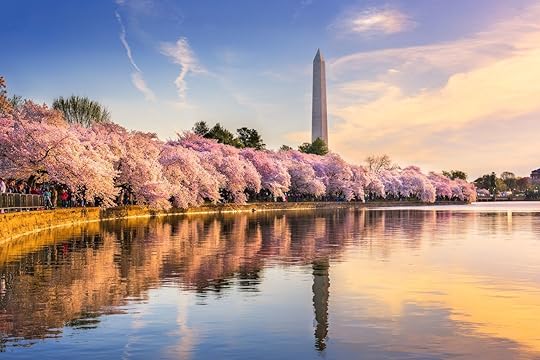
Photo: Sean Pavone/Shutterstock
Length: 8 hours, 11 minutes
Price: $103.79
Though you can really begin your journey anywhere along this route, for consistency’s sake we’re starting in the far northeastern corner of the country in a little town called Boston, Massachusetts. Here, you’ll board the very un-glamorous Northeast Regional, a commuting favorite for business travelers connecting all the major cities of the northeast.
Though the trip will take you through seven states on your way to the nation’s capital, if you’ve got some time you might want to step off and check out Providence, Rhode Island, on the way. It has one of the best Little Italys in America, plus five colleges and universities right in town. You should also definitely take a few hours and get off at Penn Station in Manhattan. Because what’s a trip around the US without at least one selfie in Times Square?
Leg two: Washington, DC, to New Orleans, Louisiana

Photo: Sean Pavone/Shutterstock
Length: 26 hours, 2 minutes
Price: $157.21
The first long leg of your journey takes you from DC deep into the heart of Dixie aboard the Amtrak Crescent. It’s a 26-hour trip, so if you’re planning to plug straight through, perhaps look into booking a roomette or bedroom, which can almost double the price. Then again, compare that to the price of getting a lay-flat seat on an airplane, and this seems like a bargain.
The ride takes you through seven southern states — Virginia, North Carolina, South Carolina, Georgia, Alabama, Mississippi, and Louisiana — before dropping you in the Crescent City. If you’re keen to get off the train, make a stop in Greenville, South Carolina, and eat your way through the best small food city in America. Or spend a couple of days exploring Atlanta before heading west. Charlotte, Greensboro, and Birmingham also have stops if you want a real southern tour.
Leg three: New Orleans, Louisiana, to Los Angeles, California

Photo: View Apart/Shutterstock
Length: 46 hours, 35 minutes
Price: $150.08
The Amtrak Sunset Limited is probably the best way to take in the sprawling desert-scapes of the American Southwest. It’s also a fantastic way to learn how big Texas is, exactly, as you’ll spend nearly an entire day of this leg rumbling through the Lone Star State. This is another ride where it’s worth springing for the sleeper cabins, but if you’re looking to break the trip up, you’ll find plenty of cool stops along the way.
Houston, San Antonio, and El Paso all have stops along the Sunset Limited, as do Tucson, Arizona, and Palm Springs. Though if you just want to gaze out the window at the red rocks and blue sky, nobody’s going to blame you.
Leg four: Los Angeles, California, to Seattle, Washington

Photo: kan_khampanya/Shutterstock
Length: 29 hours, 1 minute
Price: $137
Driving up the Pacific Coast Highway is one of the great scenic American road trips. Of course, assuming you do crazy stuff like keep your eyes on the road when you drive, it can sometimes be tough to truly appreciate the grandeur of everything you’re driving through. But hop aboard the Coast Starlight and you’ll get the majesty of California with no road to focus on as your train travels up the coast through green mountains dropping into the crashing Pacific.
Once you’ve cleared the central coast you may want to take a day and explore Sacramento, one of the more underrated restaurant cities in the US. Or get out in Portland and bike along the Willamette River before cruising through a few of its famous breweries. From there, it’s a few short hours to Seattle’s King Street Station. If you want to take a little bonus ride, jump on the Amtrak Cascades up to Vancouver, BC, for even more spectacular northwest scenery.
Leg five: Seattle, Washington, to Chicago, Illinois

Photo: Luis Boucault/Shutterstock
Length: 45 hours, 15 minutes
Price: $257.18
Though it would be hard to pick a scenic highlight of a train trip around the US, the second day of this leg is hard to beat as the Amtrak Empire Builder goes headlong into Glacier National Park. It’s as close to a train trip through Switzerland as you’ll find in the US, with your train barreling past snow-capped mountains and vast alpine lakes before dipping into the flatlands of North Dakota and Minnesota.
If you’re looking to break the trip up, might we suggest spending a couple of days in Fargo, a city that offers far more than its namesake film would suggest. If you’re lucky enough to go during fall, you absolutely must tailgate a North Dakota State football game. Even during other times of the year, Fargo is the epitome of Midwestern hospitality and has some fantastic beers you’d be hard-pressed to find elsewhere.
Leg six: Chicago, Illinois, to Cleveland, Ohio

Photo: Ami Parikh/Shutterstock
Length: 6 hours, 5 minutes
Price: $52.43
After your massive trek from the West Coast, take a few days and enjoy the Windy City with all its diehard baseball and artery-clogging food. Once you’re sufficiently stuffed, jump aboard the second-shortest leg of your trip, a scant six-hour ride aboard the Amtrak Capitol Limited to Cleveland. You’ll roll over Lake Erie as you venture into Cleveland, narrowly missing Michigan but getting a second Great Lake along your tour.
Once in Cleveland, you’ll find a surprisingly vibrant city where you can eat at James Beard award-winning restaurants or traditional Polish cafeterias. If you’re doing this trip during summer (highly recommended along the Great Lakes), catch a beachside concert at Edgewater Park. Or check out the brilliant turn-of-the-century architecture in Playhouse Square, or in downtown’s many arcades.
Leg seven: Cleveland, Ohio, to Albany, New York

Many call this the most beautiful state capitol in the country, if not one of the most beautiful buildings, period. It was the most expensive government building of its time, costing $25 million to construct between 1867 and 1899. Visit the Million Dollar Staircase, the War Room, and the Senate Chamber, and you’ll see what the Versailles-level fuss is about.
Trivia fodder: Which four New York governors went on to become President?
Greyhound station: 34 Hamilton St, about a 15-minute walk from the capitol
Photo: Shutterstock/Paul Brady Photography
Length: 8 hours, 41 minutes
Price: $67.67
Your tour of the Great Lakes continues as you roll along Lake Erie aboard the Lake Shore Limited. The ride to Albany is only about eight and a half hours, but once you’re up this way you would be remiss if you didn’t stand among the mist at Niagara Falls. Stop in Buffalo, scarf some wings, and take the half-hour trip to the falls. If you brought your passport you can even head over into Canada and do some wine tasting.
Other stops of interest include Rochester, where you can enjoy a leisurely lunch at the Genesee Brewhouse before launching into a tour of the Northeast’s best beer town. After that, you’ll enjoy the rocking motion of the train as you nap the rest of the way into Albany.
Leg eight: Albany, New York, to Boston, Massachusetts

Photo: cdrin/Shutterstock
Length: 4 hours, 47 minutes
Price: $27.68
If you’re hard-pressed to do this trip as quickly as possible, you can just stay on the Lake Shore Limited another five hours, roughly, and take it all the way to Beantown. But we suggest taking some time in Albany, if for no other reason to make a trip out to Cooperstown and the Baseball Hall of Fame. Not a baseball fan? No problem. This is the shortest leg of the trip, and after traveling 6,500 miles and spending 175 hours on trains, it might be nice to complete the loop.
Traveling in the cheapest class of service and following this route, you’ll see 27 states across seven different Amtrak lines, all for under $1,000. Which is likely less than a road trip would have cost and certainly less than flying. So if this summer the great expanse of America is calling your name, a big train trip may be just what you’re looking for. 
More like this Train Travel The world’s most epic train journeys to remote places
The post Loop from Boston to California and back on the ultimate US train trip appeared first on Matador Network.

May 20, 2020
Istanbul lockdown photos
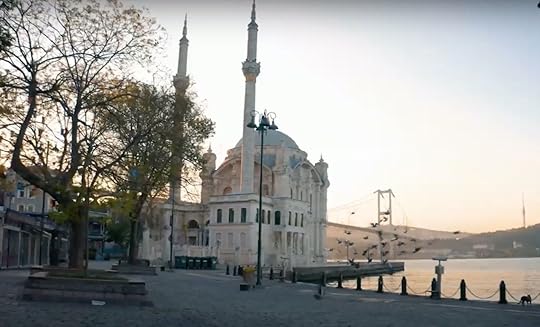
Nothing is as emotionally confusing as looking at images of a city pre-lockdown. On the one hand, it’s nice to reflect on the days when large gatherings were a thing, people were out at markets, playing in the streets, and just generally going about their lives. It reminds us that “normal” wasn’t so long ago and gives us hope that it will return one day soon. On the other hand, it shows us what we’re missing. These memories are glimpses into a time we took for granted and a world that may never be the same again. That’s why this video of Istanbul, created by Hasan ilkay Özduman, is truly a rollercoaster.
The video juxtaposes shots of pre-lockdown Istanbul — when city life went on as normal — with images of the currently empty streets. It begins by showing life in lockdown-era Istanbul, defined by absence more than anything else. Streets and parks are empty, the river is calm, and even the Hagia Sophia is deserted. It’s a scene we’re all too familiar with in our own communities.
Then the video shifts, showing scenes from a pre-lockdown Istanbul. People stroll down narrow streets, shop in crowded markets, and fish off busy piers. In the pre-COVID era, these shots would look mundane and unextraordinary. Right now, to a world confined by travel restrictions and social distancing measures, they’re like scenes from a utopia. 
More like this News Drone footage of cities around the world shows the extent of the stay-at-home restrictions
The post Photographer captures the streets of Istanbul before and during lockdown appeared first on Matador Network.

Matador Network's Blog
- Matador Network's profile
- 6 followers



